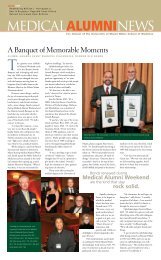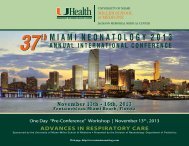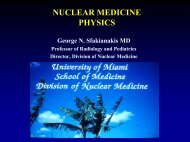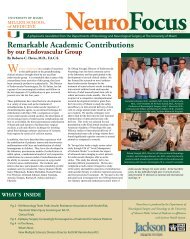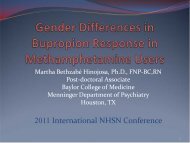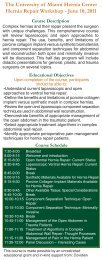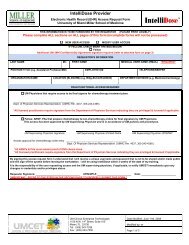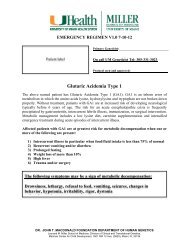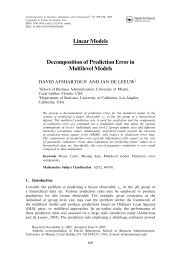Untitled - Interdisciplinary Stem Cell Institute - University of Miami
Untitled - Interdisciplinary Stem Cell Institute - University of Miami
Untitled - Interdisciplinary Stem Cell Institute - University of Miami
Create successful ePaper yourself
Turn your PDF publications into a flip-book with our unique Google optimized e-Paper software.
In its bone and skin division, associate<br />
pr<strong>of</strong>essor <strong>of</strong> dermatology Evangelos<br />
Badiavas is using cells that have been<br />
expanded and optimized at ISCI’s <strong>Cell</strong><br />
Manufacturing Laboratory to continue<br />
the groundbreaking work he began ten<br />
years ago at Brown <strong>University</strong>.<br />
“We were the first with the idea<br />
<strong>of</strong> taking a stem cell population and<br />
putting it into a chronic wound,” says<br />
Badiavas, director <strong>of</strong> ISCI’s Laboratory<br />
on Cutaneous Wound Healing and<br />
Regeneration. He and his team at<br />
Brown applied bone marrow cells topically<br />
to a surgical wound that had been<br />
open for several years. The cells rebuilt<br />
skin tissue, healing thoroughly rather<br />
than simply scarring.<br />
“It was one <strong>of</strong> those worth-it<br />
moments—all those nights in the lab,<br />
my wife being angry with me for being<br />
home late,” Badiavas recalls. “It’s a situation<br />
where you made a difference with<br />
your own hands, your own ideas.”<br />
Since arriving at ISCI in 2008,<br />
Badiavas, who did his residency and<br />
fellowship at the Miller School, has<br />
had several “worth-it” moments. He<br />
describes one patient with bilateral leg<br />
ulcers from severe veinous disease who<br />
was dependent on narcotics for pain<br />
management. Injection <strong>of</strong> the patient’s<br />
own bone marrow cells closed his<br />
wounds, restored his ability to walk,<br />
and got him <strong>of</strong>f <strong>of</strong> narcotics.<br />
Mesenchymal cells show<br />
widespread therapeutic<br />
promise because <strong>of</strong> their<br />
ability to fly under the immune system’s<br />
radar. But they alone cannot regenerate<br />
blood destroyed by chemotherapy<br />
or radiation treatment for cancer or<br />
other diseases. Hematapoietic (bloodforming)<br />
cells from healthy donors are<br />
necessary, but they introduce a serious<br />
rejection risk called graft-versus-host<br />
Through their work with stem cells, Evangelos Badiavas, associate pr<strong>of</strong>essor <strong>of</strong> dermatology and cutaneous surgery, and research<br />
associate Marcela Salgado have been able to close chronic wounds and restore patients’ independence and quality <strong>of</strong> life.<br />
disease, even when the donor is a close<br />
HLA match.<br />
“We can always shut down graftversus-host<br />
disease with steroids or other<br />
lines <strong>of</strong> immunosuppressants,” explains<br />
Krishna Komanduri, the Kalish Family<br />
Endowed Chair in <strong>Stem</strong> <strong>Cell</strong> Transplantation<br />
and director <strong>of</strong> the UM/Sylvester<br />
<strong>Stem</strong> <strong>Cell</strong> Transplant Program. “But the<br />
problem is that patients end up so pr<strong>of</strong>oundly<br />
immunodeficient they <strong>of</strong>ten<br />
die <strong>of</strong> infection.”<br />
Komanduri’s lab at ISCI is working<br />
on ways to prevent graft-versus-host<br />
disease while reducing risk <strong>of</strong> infection<br />
and relapse. A lot <strong>of</strong> his work is with<br />
T cells, components <strong>of</strong> the human immune<br />
system also vulnerable to HIV.<br />
“In many cases, the same pathogens<br />
that cause problems in HIV-infected patients<br />
also cause problems in bone marrow<br />
transplant patients,” says Komanduri,<br />
who first worked with T cells in the<br />
early 1990s at an HIV immunology lab<br />
in San Francisco, the epicenter <strong>of</strong> the<br />
AIDS epidemic at that time.<br />
When chemotherapy destroys leukemia<br />
cells, it takes T cells with it. Hematopoietic<br />
stem cell transplants also deliver<br />
new T cells from the donor, but they<br />
take time to multiply, leaving the patient<br />
vulnerable to infection. When infectionfighting<br />
T cells finally repopulate, they<br />
introduce the potential for graft-versushost<br />
disease.<br />
It turns out that not all T cells are<br />
created equal: Some can cause graftversus-host<br />
disease, and some can<br />
reverse it. Komanduri developed a<br />
novel technique, called flow cytometry,<br />
that helps isolate different types <strong>of</strong><br />
T cells. His team is working on a transplant<br />
protocol that combines these different<br />
T cells in a ratio that can quash<br />
infections and graft-versus-host disease<br />
at the same time.<br />
Komanduri is also exploring how<br />
to improve outcomes in blood cancer<br />
patients who can’t find a donor match.<br />
Cord blood transplants use stem<br />
cells from the small amount <strong>of</strong> blood<br />
that’s in a baby’s umbilical cord and<br />
placenta, usually discarded after birth.<br />
This blood contains hematapoietic<br />
stem cells, along with immature T cells<br />
that are less likely to cause graft-versushost<br />
disease. Therefore, they can be<br />
used even when they’re not a perfect<br />
HLA match. Komanduri is testing a<br />
new way <strong>of</strong> growing cord blood cells<br />
on a “feeder” layer <strong>of</strong> mesenchymal<br />
cells to boost immune recovery after<br />
transplant.<br />
Over the last 20 years, both private<br />
and public cord banks have sprouted<br />
up worldwide. Public banks accept<br />
donations for anyone in need. Private<br />
banks charge a fee to store cord blood<br />
solely for use by the family that deposited<br />
it.<br />
While a federal funding ban on research<br />
involving embryonic stem cells<br />
(those derived from an unused embryo<br />
created through in vitro fertilization)<br />
was lifted in 2009, ISCI trials don’t currently<br />
involve this category <strong>of</strong> stem cell.<br />
Hare notes that only mesenchymal cells<br />
are used in clinical trials presently under<br />
way at ISCI, but several research teams<br />
are shifting focus to a new area—tissuespecific<br />
stem cells.<br />
“What’s driving progress in the field<br />
is the discovery that every organ has its<br />
own specific stem cell,” Hare explains.<br />
“We’re working very intently now on<br />
cardiac stem cells, and we know from<br />
animal studies that these cells are more<br />
potent than mesenchymal cells.”<br />
He says this discovery, which happened<br />
within the past ten years, is one<br />
example <strong>of</strong> how quickly the science <strong>of</strong><br />
translational medicine is moving. He<br />
also gives props to patients like Deborah<br />
Wilson, who are eager to participate in<br />
the trials.<br />
“If I look back on the last ten years,<br />
I never thought we’d be this far along,”<br />
Hare admits. “I think this is ready for<br />
approval, at least in its first iteration,<br />
by 2015. It doesn’t mean we won’t<br />
improve on it. We didn’t avoid using<br />
penicillin because we were waiting for<br />
the third-generation antibiotics. We<br />
used what we had at the time that we<br />
knew worked. And we’ll do the same<br />
with stem cell therapies.”<br />
In April ISCI hosted an appreciation<br />
luncheon that drew more than 50<br />
clinical trial participants, one <strong>of</strong> whom<br />
showed his appreciation and energy<br />
level by giving a spontaneous breakdancing<br />
performance during the event.<br />
“They are seeking us out from all<br />
over the country,” Hare says <strong>of</strong> his<br />
patients. “They understand that we<br />
don’t know whether it’s going to work,<br />
but they stand shoulder to shoulder<br />
with us in the importance <strong>of</strong> doing this<br />
research.”<br />
meredith danton camel is an<br />
editorial director at the <strong>University</strong> <strong>of</strong> <strong>Miami</strong>.<br />
For more on clinical trials and stem cell<br />
research at ISCI, visit http://isci.med.miami.edu.<br />
To watch UHealth’s Suncoast Emmy Awardwinning<br />
episode <strong>of</strong> Breakthrough Medicine,<br />
“<strong>Stem</strong> <strong>Cell</strong> Therapy: Healing Force <strong>of</strong> the Future,”<br />
go to www.uhealthsystem.com/breakthrough/<br />
episode4.asp.<br />
MoreCutting-EdgeActivityatISCI<br />
t<br />
Nanette H. Bishopric, recipient <strong>of</strong> the American College <strong>of</strong> Cardiology’s 2010<br />
Distinguished Scientist Award, pr<strong>of</strong>essor <strong>of</strong> medicine, and director <strong>of</strong> the Cardiovascular<br />
Genetics Laboratory, led a team <strong>of</strong> researchers in discovering a factor that can<br />
serve as a predictor <strong>of</strong> stem cell development into blood vessels, a key finding for<br />
future applications.<br />
t David Seo, director <strong>of</strong> the Genomic Medicine Registry and associate pr<strong>of</strong>essor<br />
<strong>of</strong> medicine, Division <strong>of</strong> Cardiology, is exploring the use <strong>of</strong> bone marrow-derived<br />
stem cells to repair artherosclerosis.<br />
t Omaida Velazquez, vice chair <strong>of</strong> research surgery and David Kimmelman<br />
Endowed Chair <strong>of</strong> Vascular and Endovascular Surgery, is principal investigator <strong>of</strong> an<br />
National <strong>Institute</strong>s <strong>of</strong> Health-funded grant to study growth factors critical to the<br />
wound-healing process, among several other stem cell-related studies she is leading.<br />
t Karen Young, assistant pr<strong>of</strong>essor <strong>of</strong> clinical pediatrics, Division <strong>of</strong> Neonatology,<br />
is studying how stem cells become lung cells. She received the 2010 Micah<br />
Batchelor Award for Excellence in Children’s Health Research and a $300,000 grant<br />
for research that aims to identify factors leading to impaired lung cell development<br />
in premature infants.<br />
18 <strong>Miami</strong> magazine Fall 2011 Fall 2011 <strong>Miami</strong> magazine 19




